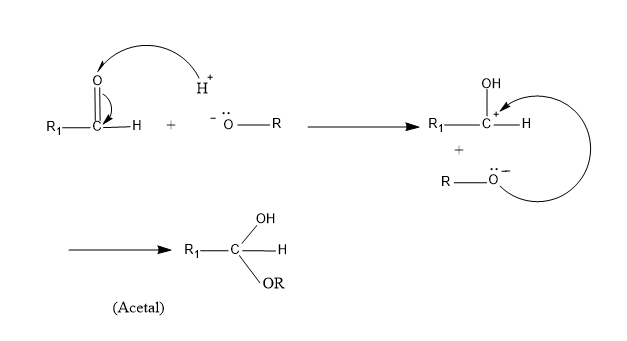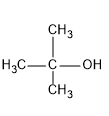
In the following reaction,
$Aldehyde+Alcohol\xrightarrow{HCl}Acetal$
Aldehyde Alcohol HCHO t-BuOH $C{{H}_{3}}CHO$ MeOH
Predict the best combinations from the above given aldehydes and alcohols:
A) HCHO and MeOH
B) HCHO and t-BuOH
C) $C{{H}_{3}}CHO$ and MeOH
D) $C{{H}_{3}}CHO$and t-BuOH
| Aldehyde | Alcohol |
| HCHO | t-BuOH |
| $C{{H}_{3}}CHO$ | MeOH |
Answer
456.3k+ views
Hint: For the acetal formation aldehyde acts as the electrophile and alcohol acts as the nucleophile.Inductive effect plays a major role in the reactivity of a compound.
Complete answer:
In this question, a reaction is given in which an aldehyde and an alcohol combines and forms an acetal.
We are also provided with two aldehydes-formaldehyde and acetaldehyde and two alcohols- tertiary butanol and methanol. We have to say the best combination of the aldehyde and alcohol given in the table for the formation of acetal.
So we know that for the formation of acetal and for reaction to happen there should be an electrophile and nucleophile. And to know the best combinations of aldehyde and alcohol we should know the mechanism of acetal formation.
When an alcohol reacts with aldehyde, the acidic hydrogen atom of alcohol (-OH) attacks the carbonyl oxygen atom resulting in breaking of the double bond of aldehyde and the remaining alkoxide group of the alcohol attacks the carbon by nucleophilic attack. So here aldehyde acts as the electrophile and the alcohol as the nucleophile.

Now we have to find the best combination of aldehyde and alcohol for the effective reaction of acetal formation.
First, we have to select the aldehyde for the reaction, here formaldehyde and acetaldehyde is given as the options. First let’s see the structure of these two aldehydes.
Here if we compare these both aldehyde, acetaldehyde is having a methyl group and the methyl group is having +I effect i.e. positive inductive effect and it donates electrons to the carbonyl carbon and it makes the C less electrophilic. Hence acetaldehyde will be less electrophilic than formaldehyde as there is no methyl group in formaldehyde to possess +I effect.So from the two options, HCHO is the best option.
Now let’s move on to alcohol.
Here if we compare the structure, as alcohol acts as the nucleophile, it should have more nucleophilic nature. Here t-BuOH is having three methyl group and hence it is more nucleophilic than MeOH, but
t-BuOH will not attack the aldehyde effectively due to steric hindrance as the tertiary alkyl group is a bulky group.
Hence here MeOH will attack with the aldehyde effectively.
Hence the best combination for the acetal formation is HCHO and MeOH.

The correct option from the given combination is option (A).
Note:
An electrophile is a species which consists of positive charge on it resulting from lack of electrons on carbon atoms and nucleophile is the species with negative charge and it seeks an electrophile to form a stable compound.
Complete answer:
In this question, a reaction is given in which an aldehyde and an alcohol combines and forms an acetal.
We are also provided with two aldehydes-formaldehyde and acetaldehyde and two alcohols- tertiary butanol and methanol. We have to say the best combination of the aldehyde and alcohol given in the table for the formation of acetal.
So we know that for the formation of acetal and for reaction to happen there should be an electrophile and nucleophile. And to know the best combinations of aldehyde and alcohol we should know the mechanism of acetal formation.
When an alcohol reacts with aldehyde, the acidic hydrogen atom of alcohol (-OH) attacks the carbonyl oxygen atom resulting in breaking of the double bond of aldehyde and the remaining alkoxide group of the alcohol attacks the carbon by nucleophilic attack. So here aldehyde acts as the electrophile and the alcohol as the nucleophile.

Now we have to find the best combination of aldehyde and alcohol for the effective reaction of acetal formation.
First, we have to select the aldehyde for the reaction, here formaldehyde and acetaldehyde is given as the options. First let’s see the structure of these two aldehydes.
Formaldehyde 
| Acetaldehyde
|
Here if we compare these both aldehyde, acetaldehyde is having a methyl group and the methyl group is having +I effect i.e. positive inductive effect and it donates electrons to the carbonyl carbon and it makes the C less electrophilic. Hence acetaldehyde will be less electrophilic than formaldehyde as there is no methyl group in formaldehyde to possess +I effect.So from the two options, HCHO is the best option.
Now let’s move on to alcohol.
t-BuOH
| MeOH
|
Here if we compare the structure, as alcohol acts as the nucleophile, it should have more nucleophilic nature. Here t-BuOH is having three methyl group and hence it is more nucleophilic than MeOH, but
t-BuOH will not attack the aldehyde effectively due to steric hindrance as the tertiary alkyl group is a bulky group.
Hence here MeOH will attack with the aldehyde effectively.
Hence the best combination for the acetal formation is HCHO and MeOH.

The correct option from the given combination is option (A).
Note:
An electrophile is a species which consists of positive charge on it resulting from lack of electrons on carbon atoms and nucleophile is the species with negative charge and it seeks an electrophile to form a stable compound.
Recently Updated Pages
Can anyone list 10 advantages and disadvantages of friction

What are the Components of Financial System?

How do you arrange NH4 + BF3 H2O C2H2 in increasing class 11 chemistry CBSE

Is H mCT and q mCT the same thing If so which is more class 11 chemistry CBSE

What are the possible quantum number for the last outermost class 11 chemistry CBSE

Is C2 paramagnetic or diamagnetic class 11 chemistry CBSE

Trending doubts
Which is not a source of freshwater 1 Glaciers and class 11 chemistry CBSE

10 examples of friction in our daily life

The correct order of melting point of 14th group elements class 11 chemistry CBSE

Difference Between Prokaryotic Cells and Eukaryotic Cells

One Metric ton is equal to kg A 10000 B 1000 C 100 class 11 physics CBSE

What is the specific heat capacity of ice water and class 11 physics CBSE




